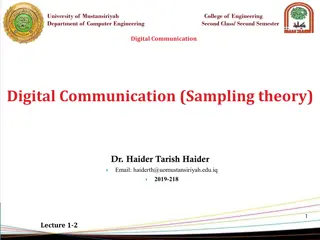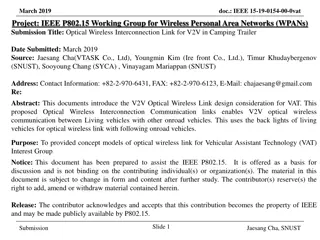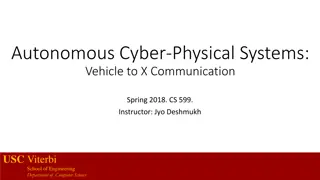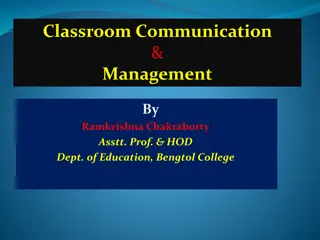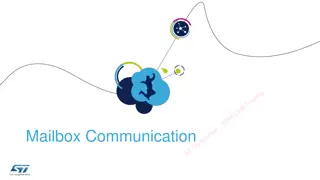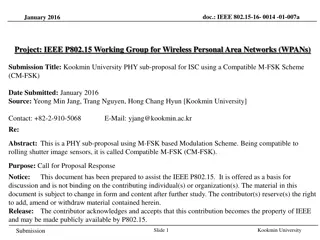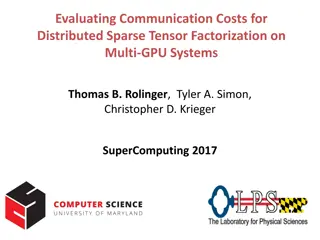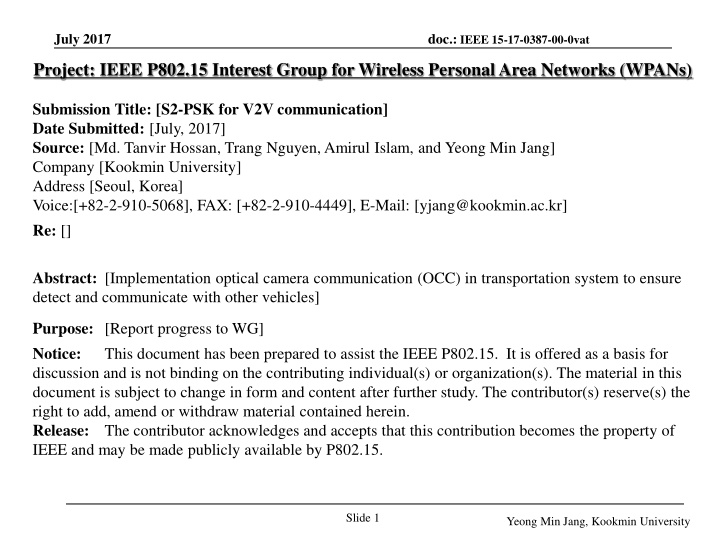
Optical Camera Communication for V2V in Transportation Systems
Explore the implementation of optical camera communication (OCC) in transportation systems to enhance vehicle-to-vehicle (V2V) communication. This technology ensures effective detection and communication with other vehicles, crucial for traffic control, surveillance applications, and autonomous driving, especially in low light conditions. Learn about the Spatial 2-Phase Shift Keying (S2-PSK) methodology and Region-of-Interest (RoI) signaling techniques for improved V2V communication and vehicle detection.
Download Presentation

Please find below an Image/Link to download the presentation.
The content on the website is provided AS IS for your information and personal use only. It may not be sold, licensed, or shared on other websites without obtaining consent from the author. If you encounter any issues during the download, it is possible that the publisher has removed the file from their server.
You are allowed to download the files provided on this website for personal or commercial use, subject to the condition that they are used lawfully. All files are the property of their respective owners.
The content on the website is provided AS IS for your information and personal use only. It may not be sold, licensed, or shared on other websites without obtaining consent from the author.
E N D
Presentation Transcript
July 2017 doc.: IEEE 15-17-0387-00-0vat Project: IEEE P802.15 Interest Group for Wireless Personal Area Networks (WPANs) Submission Title:[S2-PSK for V2V communication] Date Submitted: [July, 2017] Source: [Md. Tanvir Hossan, Trang Nguyen, Amirul Islam, and Yeong Min Jang] Company [Kookmin University] Address [Seoul, Korea] Voice:[+82-2-910-5068], FAX: [+82-2-910-4449], E-Mail: [yjang@kookmin.ac.kr] Re: [] Abstract: [Implementation optical camera communication (OCC) in transportation system to ensure detect and communicate with other vehicles] Purpose: [Report progress to WG] Notice: This document has been prepared to assist the IEEE P802.15. It is offered as a basis for discussion and is not binding on the contributing individual(s) or organization(s). The material in this document is subject to change in form and content after further study. The contributor(s) reserve(s) the right to add, amend or withdraw material contained herein. Release: The contributor acknowledges and accepts that this contribution becomes the property of IEEE and may be made publicly available by P802.15. Slide 1 Yeong Min Jang, Kookmin University
July 2017 doc.: IEEE 15-17-0387-00-0vat IEEE 802.15 IG VAT Spatial 2-Phase Shift Keying (S2-PSK) for vehicle- to-vehicle (V2V) communication Slide 2 Yeong Min Jang, Kookmin University
July 2017 doc.: IEEE 15-17-0387-00-0vat Introduction V2V communication and vehicle detection plays an increasingly important role in traffic control, surveillance applications, and autonomous driving. These are more challenging in both day and night time due to the low contrast and luminosity. Region-of-interest (RoI) signaling techniques applied to camera (Rx) ton achieve high frame rate for RoI based V2V communication and vehicles detection. Slide 3 Yeong Min Jang, Kookmin University
July 2017 RoI signaling system using S2-PSK (1/2) doc.: IEEE 15-17-0387-00-0vat The transmission of RoI is beneficial when the camera Rx knows the area in which the communication link should be setup. The light source Tx shall continuously inform the camera Rx via a known signal for differentiating the light source Tx from other non-interested light sources and other objects. The transmission of the known signal is a type of light source identification. Slide 4 Yeong Min Jang, Kookmin University
July 2017 RoI signaling system using S2-PSK (2/2) doc.: IEEE 15-17-0387-00-0vat Transmitter Diagram Receiver Diargram S2-PSK encoder Vehicular identification Low speed camera Left LED array Vehicular identification S2-PSK decoder Dimmer RoI update High-rate stream encoder High-rate stream decoder High speed camera Right LED array High-rate data stream High-rate data stream Optical Channel Slide 5 Yeong Min Jang, Kookmin University
July 2017 RoI signaling S2-PSK waveform (1/2) doc.: IEEE 15-17-0387-00-0vat The camera Rx first detects the RoI from the light source identification signal, and then selects the RoI to accelerate the frame rate and achieve high-speed data link. The low frame-rate (e.g. 30fps) camera shall be used to detect the RoI to reduce cost. Slide 6 Yeong Min Jang, Kookmin University
July 2017 RoI signaling S2-PSK waveform (2/2) doc.: IEEE 15-17-0387-00-0vat bit 0 bit 1 LED-1 waveform Dimming control LED-2 waveform Sampling (t=t2) Sampling (t=t1) XOR(1;1) = 0 XOR(1;0) =1 Slide 7 Yeong Min Jang, Kookmin University








